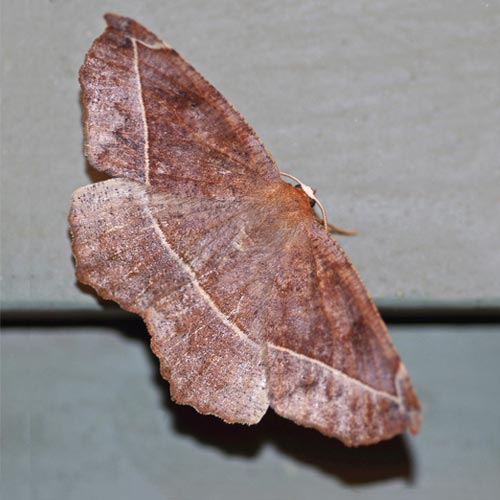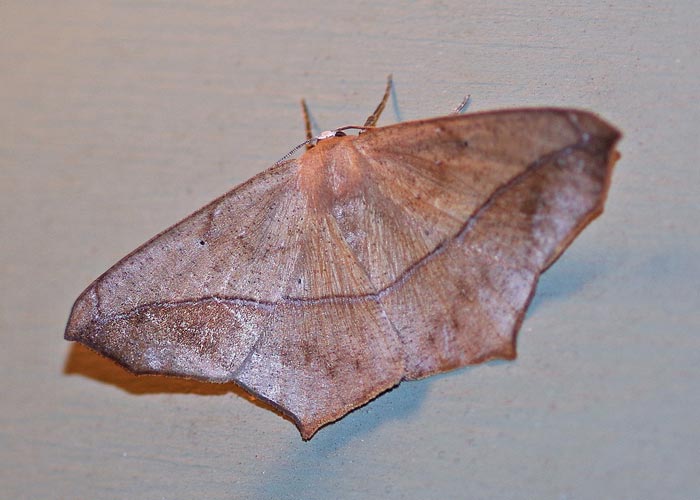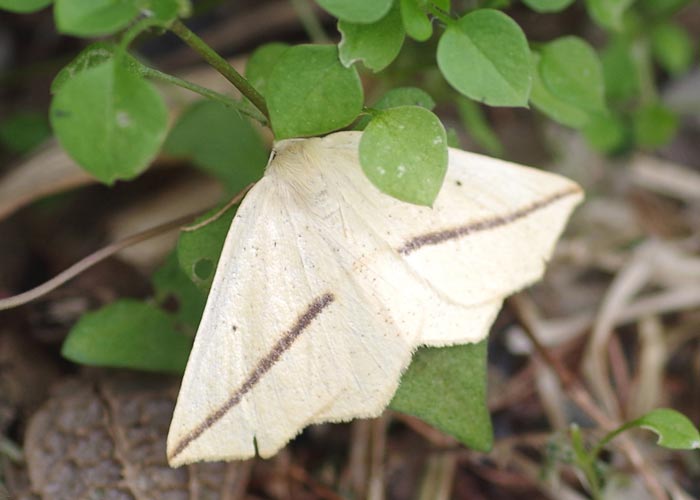Salutations, BugFans,
Some birders use the acronym “LBJs” (“little brown jobs”) to refer to small, indistinguishable Passerines (perching birds). The BugLady has taken lots of LBJ moth pictures that will likely languish unidentified in her “X-files” until she serendipitously sees their picture while she’s looking for something else. Happily, she was able to hang names on these three handsome members of the family Geometridae.
Geometridae comes from two Greek words that mean “to measure the earth,” a reference to the locomotion of Geometrid larvae. Where other caterpillars have a pair of prolegs on each of their final five abdominal segments, Geometrids have them on only the last two (caterpillars have three pairs of jointed, true legs that are, as they are in the adults, located are on the thorax. Prolegs are, according to Bugguide.net, “fleshy foot-like organs that serve various larvae in place of, or in addition to, legs” (true legs lie to the fore, and prolegs lie aft.). As a result, instead of undulating along, Geometrids move across their landscapes by raising their head end up and extending it, latching onto something, and then pulling the rear end up to the front. They look like they are measuring their terrain, and alternate names include inchworms, loopers, and spanworms (although there are a few unrelated larvae that are called loopers).
It’s a huge family, with 35,000 species worldwide (1,400-plus in North America). As a group, adults are slender, with broad wings that they hold flat in an almost butterfly-like posture, and many have wingspreads in the one-inch+ range. They are often highly camouflaged, nocturnal, and they have ears (tympanal organs) that let them monitor bat activity. The larvae are leaf-eaters (some eat agriculturally important leaves) and twig-mimics (when alarmed, they stretch out straight and look twiggy). Geometrid caterpillars are immeasurably important to those LBJs and other spring migrants because many are conspicuous during late spring migration and in early summer when parent birds have hungry mouths to feed.
Eutrapela clemataria
Eutrapela clemataria has one name for its adult stage—Curved-Toothed Geometer Moth—and another for its larva—Purplish-Brown Looper (in Maine, where it is uncommon, it’s called the Big Cranberry Spanworm, and it eats cranberry buds and flowers). It is the only species in its genus. CTGs can be found in woodlands east of the Great Plains (or under the BugLady’s porch light).

Adults have wingspans of about 1 ½;” females are larger than males, and males’ wings are more rounded. There’s a lot of variation in color in both adult and caterpillar stages. An adult sitting on dead leaves is pretty hard to spot.
Caterpillars feed on leaves of many kinds of trees, including ash, basswood, elderberry, oak, poplar, and willow. Wagner, in Caterpillars of Eastern North America says that, “When at rest, the Purplish-brown Looper adopts one of two postures. In the first, the legs are held tightly against the thorax and the head is rolled under; the anterior of the body thus resembles a fist. In the second, the swollen legs on T3 [third segment of the thorax] are held outward, in such a way as to resemble the scar left after a leaf has dropped from a twig.”
Large Maple Spanworm (Prochoerodes lineola)
Not surprisingly, the CTG is listed as one of the species that can be confused with the Large Maple Spanworm (Prochoerodes lineola). The CTG has scalloped margins on its hind wings, and each of the LMS’s wings ends in a little point. Its habitat and range are very similar to the CTG, (ditto the porch light).
Wagner tells us that “Seasonal phenology remains unclarified in the Northeast, where there seems to be a single principal generation, with mature caterpillars from June through August; southward with two to three generations.” The LMS moth pictured here was photographed at the end of its flight period in late September.

LMS caterpillars eat the leaves of trees and shrubs like white birch, willow, tamarack, aspen, fir, and dogwood, plus some herbaceous plants like soybean, sweetfern, and members of the geranium family. Oh yes, and maple.
Yellow Slant-Line
This particular Yellow Slant-Line (Tetracis crocallata) (crocallata, from the Greek krokos meaning “saffron”/”saffron-colored” ) isn’t very yellow, and it has fewer speckles on its wings than most YSLs do but it does have the brown discal spot on the wing that separates it from the look-alike White Slant-line.

Like our other two Geometers, it’s found in woodlands and shrublands from the Great Plains, east, but it is described as more of a habitat generalist. There’s a single generation here in Wisconsin, but two generations south of us. Adults fly in late spring, and YSLs overwinter as pupae. From the Report of the United States Geological Survey of the Territories, Volume 10 (1876) we learn that
Eggs are deposited about 100 in one spot, in curving, somewhat angulated rows, which have the appearance somewhat of radiating from a common center. When first laid they were yellow-green; on the 20th they became ochro-olivaceous; on the 21st indian red, and by the 28th or 29th, the greater part appeared gray… the enormous head and anal segments gave these caterpillars the appearance of minute, animated dumb bells… They were very active, almost constantly in motion. Each time, before looping, it rears itself up on its hind legs and turns round in every direction, as if scrutinizing the neighborhood. I tried in vain to rear them, experimenting with almost every food plant I could think of.
More recent sources say that the caterpillars eat leaves of alder, sumac, willow, red elderberry, and, formerly, chestnut, and that wild birds will not eat them, which suggests that they may be unpalatable or toxic. YSLs were included in a study by Theodore Sargent of the “Relative acceptability of butterflies and moths to local [Massachusetts] birds” (1995). Dead butterflies and moths in sizes small, medium, and large were presented to birds at a feeding station; the study yielded some interesting results.
First, size does matter. Even they required more processing (de-winging) and therefore a higher caloric investment by the birds, the medium and large moths were preferred. Small moths were often picked up and dropped, as though they were being rejected based on their relative weight. Second, a high number of cryptically-colored/bark-like moths were regarded as USDA Choice by the birds. Third, surprisingly, aposematically-colored moths were quite desirable; in fact, with a few exceptions, warning coloration almost guaranteed that a moth would be selected by a bird (Sargent speculates that a dead moth with warning coloration is unable to communicate additionally with predators via behavioral and biochemical signals). And fourth, birds seem to like moths more than butterflies. Sargent also did a small-scale study offering both dead moths and live moths (which he slowed down by refrigerating them) and the birds overwhelmingly took the live prey.
The Bug Lady